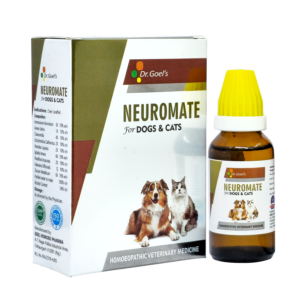
Say goodbye to epilepsy and seizures: Neuromate
The amazing and complex organ, the brain, is the source of all thought and consciousness. This amazing organ is crucial in determining our beloved canine companions’ behavior, feelings, and general well-being. Similar to humans, dogs have a sophisticated network of synapses and neurons that facilitate the processing and assimilation of information.
Let’s explore the amazing powers of the canine brain in today’s blog post and any potential dysfunction that can result in the neurological condition known as epilepsy.
The Master Orchestra Conductor: The Brain.
A dog’s brain, a marvel of biological engineering that controls all of its thoughts, movements, and emotions, is at the center of its being. The complex web of a dog’s cognitive capacities is woven together by a symphony of electrical impulses, chemical messengers, and intricate connections within this organ. Despite being different from the human brain, the canine brain and the human brain have many structural and functional similarities. It consists of a number of areas, each with a unique purpose in processing information and controlling biological operations.
The canine brain is a complex terrain of neuronal networks that shapes a dog’s behavior and responses to its environment, from the frontal cortex responsible for decision-making and problem-solving to the limbic system linked with emotions and memory.
Dogs are able to sense their surroundings, recognize familiar faces and scents, and respond to stimuli with astonishing accuracy and efficiency thanks to the brain’s capacity to process and integrate sensory data. A dog’s brain is continually absorbing, learning from, and adjusting to its experiences, whether it’s a game of fetch, a scent trail to follow, or a challenging training exercise.
“However, just as the brain can be a source of wonder, it can also be vulnerable to dysfunction and disorder.”
One example of a canine brain disorder is epilepsy, a neurological ailment marked by recurring seizures. The brain’s delicate balance is upset by aberrant electrical activity during seizures, which can emerge as a variety of physical and behavioral symptoms. Since epilepsy can cause sudden, unpredictable seizures that vary in severity and duration, it can significantly negatively influence a dog’s quality of life.
What are the causes of Epilepsy?
Since many different disorders have the potential to cause it, epilepsy should be viewed as a general word. Our body is comparable to a flawless, well-planned play. The brain ultimately depends on all other organs for proper function. Technically speaking, the brain connects to many bodily parts through the neural network and neurons. Let’s quickly review all the things that could contribute to epileptic seizures. Here’s a list of all possible factors that can possibly lead to seizures-
1. Genetic Predisposition:
Certain breeds are more likely to develop epilepsy, indicating a genetic component.
Breeds such as Beagles, Boxers, Border Collies, Golden Retrievers, and German Shepherds are known to have a higher predisposition.
Inherited epilepsy can be passed on from affected dogs to their offspring.
2. Structural Abnormalities in the Brain:
Brain abnormalities, such as tumors, cysts, or malformations, can disrupt normal brain activity and lead to seizures. Structural abnormalities can occur due to genetic factors, developmental issues, or acquired conditions.
These abnormalities may affect specific regions of the brain responsible for regulating electrical activity.
3. Toxic Exposures:
Exposure to certain toxins and chemicals can induce seizures in dogs.
Ingestion of substances like-
- lead
- pesticides
- fertilizers
- toxic plants
these can affect the central nervous system and provoke seizures. Some medications or drug reactions can also trigger epileptic seizures in dogs.
4. Infectious Diseases:
Infections affecting the central nervous system can lead to epilepsy. Diseases such as-
- Distemper
- Encephalitis
- Meningitisbrain
- Abscesses
Inflammatory processes and scarring in the brain can disrupt normal neuronal activity and precipitate epileptic episodes.
5. Head Trauma:
Traumatic brain injuries, such as a severe blow to the head or a car accident, can cause epilepsy in dogs. Head trauma can lead to structural damage, bleeding, or swelling in the brain, resulting in abnormal electrical discharges and seizures.
The development of post-traumatic epilepsy may occur months or even years after the initial injury.
6. Developmental Disorders:
Some dogs are born with developmental defects that make them more prone to seizures. Hydrocephalus (excessive fluid in the brain), cerebellar hypoplasia (cerebellum underdevelopment), and neuronal migration abnormalities can all impair normal brain function and contribute to seizures.
7. Idiopathic Reasons:
While the exact causes of epilepsy in dogs are not fully understood, genetic predisposition, structural abnormalities in the brain, and environmental factors are believed to play a role. Epilepsy can be challenging to manage, requiring careful monitoring, medication, and supportive care to minimize the frequency and impact of seizures.
Detecting seizures: a step-to-step guide.
Both dogs and their owners may find experiencing seizures to be upsetting. Knowing how to spot a seizure’s warning signals is essential to help the affected dog as soon as possible. This step-by-step manual seeks to assist dog owners in recognizing seizures in their canine friends and taking the necessary action. By becoming familiar with the steps below, you can be better prepared to manage a seizure episode and get veterinary help when necessary.
Step 1: Observe Changes in Behaviour
Keep a tight eye on your dog’s behavior and take note of any odd behaviors that might portend a coming seizure.
Some dogs may exhibit behaviors like excessive salivation, whimpering, or hiding as a precursor to a seizure. Look for subtle changes, such as restlessness, pacing, or clinginess, which can occur in the pre-seizure phase.
Step 2: Recognize the Aura (Pre-seizure Phase)
The moment just before a seizure begins is known as the aura. During this time, your dog may display unusual behavior like looking off into space, becoming disoriented, or acting unresponsive. Some dogs may display signs of anxiety or restlessness or seek solace from their owners.
Step 3: Identify the Seizure Activity
The duration and intensity of seizure activity can change. The three main phases of a generalized seizure are the tonic, clonic, and post-ictal phases.
- The dog may pass out, become unconscious, and become rigid during the tonic period
- The repetitive twitching, paddling, and contraction of muscles that characterise the clonic phase.
- The post-ictal phase, which comes after the seizure, is characterised by bewilderment, disorientation, momentary blindness, or drowsiness.
Step 4: Note the Duration and Frequency
Keep track of how long the seizure lasted so that your veterinarian can determine its severity and the best course of action.Most seizures last between a few seconds and a few minutes, but lengthier ones, called status epilepticus, can be fatal and call for rapid veterinary care.
Keep track of how often you have seizures.
It is essential to visit a veterinarian if your dog has frequent seizures or has more than one seizure in a 24-hour period.
Step 5: Document the Seizure
While it could be challenging to maintain composure during a seizure, make an effort to record the incident for your veterinarian.
Note the date, time, and details of the seizure, including the progression of symptoms and the length of each episode.
Record the seizure on camera to give your veterinarian a visual record of the incident.
Step 6: Ensure a Safe Environment
It’s crucial to provide your dog with a secure environment during a seizure in order to prevent harm. Remove any dangerous furniture or things from the vicinity, such as sharp objects.
Avoid attempting to restrain your dog while they are having a seizure because this could further harm them. Speak softly to your dog to reassure them and let them know you are there.
Step 7: Contact Your Veterinarian
After a seizure, speak with your veterinarian to discuss the incident and get more advice.
Share the details you’ve recorded with them, such as the length and frequency of seizures.
To identify the underlying cause of the seizures, your veterinarian will do a comprehensive examination and could advise diagnostic procedures, such as blood testing or imaging.
Step 8: Consider Treatment Options
Your veterinarian may advise treatment to control the problem depending on the frequency and intensity of the seizures.
Anticonvulsant drugs, dietary adjustments, and complementary therapy are some possible treatments.It is essential to adhere to your veterinarian’s recommendations for drug administration and routine follow-up visits.
Step 9: Maintain a Seizure Diary
Monitoring your dog’s seizure activity, reaction to the medication, and any potential triggers can be done by keeping a seizure diary.
Take note of any behavioral modifications, environmental circumstances, or prescription interactions that might be related to seizure occurrences.
This information might help your vet modify the treatment approach as necessary.
Remember that detecting seizures in dogs necessitates close observation and early veterinary care. You can offer your dog the appropriate assistance and care during and after a seizure episode if you are watchful and proactive. Working along with your veterinarian, you may create a complete management plan to maintain your pet’s health.
To control convulsions, your veterinarian will usually start treating epilepsy with medicine immediately away. Finding the proper drug and dosage can be a difficult task. When deciding which medication to administer, your veterinarian will examine your pet’s condition, the frequency of seizures, the age of the pet, and other considerations. Anti-epileptic medicines that control seizures are usually recommended.
Neuromate for pets is a unique formulation for neurological problems in pets, utilised as an additional therapy for aberrant brain activity and neurological disorders such as epilepsy.
The presence of epilepsy emphasizes the complexities and sensitivity of the canine brain. Its delicate equilibrium can be upset by various events, resulting in various neurological illnesses and ailments. These disorders serve as devastating reminders of the importance of brain health and the importance of early identification, diagnosis, and appropriate management to maintain our canine companions’ well-being.
Understanding the wonders and intricacies of the canine brain allows us to develop a greater respect for our four-legged companions and aim to provide them with the care and support they require to grow mentally and emotionally.
HOMEOPATHY SOLUTION FOR EPILEPSY & SEIZURES IN PETS

NEUROMATE HOMEOPATHIC REMEDY FOR EPILEPSY & SEIZURES
Epilepsy & Seizures is a growing concern with pets and is a very common problem in veterinary. Epilepsy, sometimes called a seizure disorder, is a sudden, involuntary change in behavior, muscle control, consciousness, and/or sensation. A seizure is often accompanied by an abnormal electrical discharge in the brain. The discomfort of the dog and the helplessness of the pet owners can be addressed with NEUROMATE for PET, a Homeopathic Veterinary Medicine to treat Epilepsy symptoms for any reason.STRESSZA FOR PETS STRESS AND ANXIETY
STRESSZA for pets is an excellent remedy for treating Anxiety, Stress, and Canine Distemper. When your fur baby is unanimously scratching, barking, hiding behind, feeling anxious, eating nothing, even sometimes behaving wild or attacking unknowingly, etc. these all symptoms may be due to Anxiety and Stress or due to various causes of Canine Distemper. We have the best solution to all your problems, We have STRESSZA is a unique homeopathic veterinary formulation to relieve stress in pets.
Stressza for pets works for Stress due to Traveling, Crackers in Festive Season, Fighting with stray dogs, Home alone, Visiting Hospital for Vaccination, etc.
ME & MY VITALITY SUPPLEMENT FOR STRESS & ANXIETY
This is a unique supplement for pets experiencing extreme lassitude (inactiveness), depression, nervousness, irritability, hysterical behavior, night terror, insomnia, and other related symptoms.










